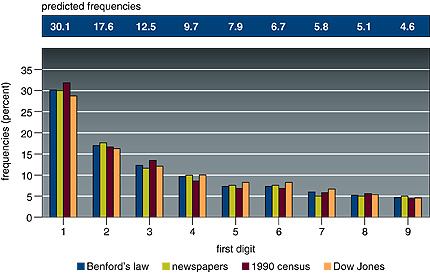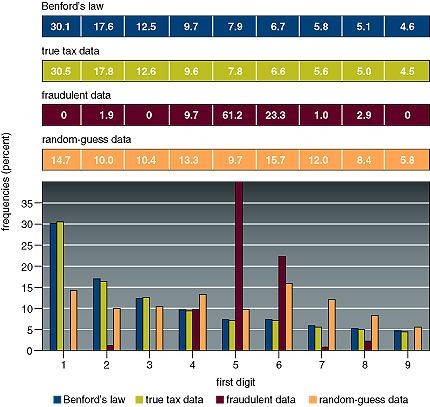Looking Out for Number 1
Following Benford's LawIf scientific reasoning were limited to the logical processes of arithmetic, we should not get very far in our understanding of the physical world. - Vannevar Bush by Malcolm W Browne Dr Theodore P Hill asks his mathematics students at the Georgia Institute of Technology to go home and either flip a coin 200 times and record the results, or merely pretend to flip a coin and fake 200 results. The following day he runs his eye over the homework data, and to the students' amazement, he easily fingers nearly all those who faked their tosses. "The truth is," he said in an interview, "most people don't know the real odds of such an exercise, so they can't fake data convincingly." There is more to this than a classroom trick. Dr Hill is one of a growing number of statisticians, accountants and mathematicians who are convinced that an astonishing mathematical theorem known as Benford's Law is a powerful and relatively simple tool for pointing suspicion at frauds, embezzlers, tax evaders, sloppy accountants and even computer bugs. The income tax agencies of several nations and several states, including California, are using detection software based on Benford's Law, as are a score of large companies and accounting businesses. Benford's Law is named for the late Dr Frank Benford, a physicist at the General Electric Company. In 1938 he noticed that pages of logarithms corresponding to numbers starting with the numeral 1 were much dirtier and more worn than other pages. A logarithm is an exponent. Any number can be expressed as the fractional exponent - the logarithm - of some base number, such as 10. Published tables permit users to look up logarithms corresponding to numbers, or numbers corresponding to logarithms. Logarithm tables (and the slide rules derived from them) are not much used for routine calculating anymore; electronic calculators and computers are simpler and faster. But logarithms remain important in many scientific and technical applications, and they were a key element in Dr Benford's discovery. Dr Benford concluded that it was unlikely that physicists and engineers had some special preference for logarithms starting with 1. He therefore embarked on a mathematical analysis of 20,229 sets of numbers, including such wildly disparate categories as the areas of rivers, baseball statistics, numbers in magazine articles and the street addresses of the first 342 people listed in the book American Men of Science. All these seemingly unrelated sets of numbers followed the same first-digit probability pattern as the worn pages of logarithm tables suggested. In all cases, the number 1 turned up as the first digit about 30% of the time, more often than any other.
Figure 1 Dr Benford derived a formula to explain this. If absolute certainty is defined as 1 and absolute impossibility as 0, then the probability of any number "d" from 1 through 9 being the first digit is log to the base 10 of (1 + 1/d). This formula predicts the frequencies of numbers found in many categories of statistics. Probability predictions are often surprising. In the case of the coin-tossing experiment, Dr Hill wrote in the current issue of the magazine American Scientist, a "quite involved calculation" revealed a surprising probability. It showed, he said, that the overwhelming odds are that at some point in a series of 200 tosses, either heads or tails will come up 6 or more times in a row. Most fakers don't know this and avoid guessing long runs of heads or tails, which they mistakenly believe to be improbable. At just a glance, Dr Hill can see whether or not a student's 200 coin-toss results contain a run of 6 heads or tails; if they don't, the student is branded a fake. Even more astonishing are the effects of Benford's Law on number sequences. Intuitively, most people assume that in a string of numbers sampled randomly from some body of data, the first non-zero digit could be any number from 1 through 9. All those numbers would be regarded as equally probable. But, as Dr Benford discovered, in a huge assortment of number sequences - random samples from a day's stock quotations, a tournament's tennis scores, the numbers on the front page of The New York Times, the populations of towns, electricity bills in the Solomon Islands, the molecular weights of compounds the half-lives of radioactive atoms and much more - this is not so. Given a string of at least 4 numbers sampled from one or more of these sets of data, the chance that the first digit will be 1 is not one in nine, as many people would imagine; according to Benford's Law, it is 30.1%, or nearly 1 in 3. The chance that the first number in the string will be 2 is only 17.6%, and the probabilities that successive numbers will be the first digit decline smoothly up to 9, which has only a 4.6% chance. A strange feature of these probabilities is that they are "scale invariant" and "base invariant." For example, it doesn't matter whether the numbers are based on the dollar prices of stocks or their prices in yen or marks, nor does it matter if the numbers are in terms of stocks per dollar; provided there are enough numbers in the sample, the first digit of the sequence is more likely to be 1 than any other. The larger and more varied the sampling of numbers from different data sets, mathematicians have found, the more closely the distribution of numbers approaches what Benford's Law predicted. One of the experts putting this discovery to practical use is Dr Mark J Nigrini, an accounting consultant affiliated with the University of Kansas who this month joins the faculty of Southern Methodist University in Dallas. Dr Nigrini gained recognition a few years ago by applying a system he devised based on Benford's Law to some fraud cases in Brooklyn. The idea underlying his system is that if the numbers in a set of data like a tax return more or less match the frequencies and ratios predicted by Benford's Law, the data are probably honest. But if a graph of such numbers is markedly different from the one predicted by Benford's Law, he said, "I think I'd call someone in for a detailed audit."
Figure2 Some of the tests based on Benford's Law are so complex that they require a computer to carry out. Others are surprisingly simple; just finding too few ones and too many sixes in a sequence of data to be consistent with Benford's Law is sometimes enough to arouse suspicion of fraud. Robert Burton, the chief financial investigator for the Brooklyn District Attorney, recalled in an interview that he had read an article by Dr Nigrini that fascinated him. "He had done his Phd dissertation on the potential use of Benford's Law to detect tax evasion, and I got in touch with him in what turned out to be a mutually beneficial relationship. Our office had handled 7 cases of admitted fraud, and we used them as a test of Dr Nigrini's computer program. It correctly spotted all 7 cases as 'involving probable fraud'." One of the earliest experiments Dr Nigrini conducted with his Benford's Law program was an analysis of President Clinton's tax return. Dr Nigrini found that it probably contained some rounded-off estimates rather than precise numbers, but he concluded that his test did not reveal any fraud. The fit of number sets with Benford's Law is not infallible. "You can't use it to improve your chances in a lottery," Dr Nigrini said. "In a lottery someone simply pulls a series of balls out of a jar, or something like that. The balls are not really numbers; they are labelled with numbers, but they could just as easily be labelled with the names of animals. The numbers they represent are uniformly distributed, every number has an equal chance, and Benford's Law does not apply to uniform distributions." Another problem Dr Nigrini acknowledges is that some of his tests may turn up too many false positives. Various anomalies having nothing to do with fraud can appear for innocent reasons. For example, the double digit 24 often turns up in analyses of corporate accounting, biasing the data, causing it to diverge from Benford's Law patterns and sometimes arousing suspicion wrongly, Dr Nigrini said. "But the cause is not real fraud, just a little shaving. People who travel on business often have to submit receipts for any meal costing $25 or more, so they put in lots of claims for $24.90, just under the limit. That's why we see so many 24's." Dr Nigrini said he believes that conformity with Benford's Law make it possible to validate procedures developed to fix the Year 2000 problem - the expectation that many computer systems will go awry because of their inability to distinguish the year 2000 from the year 1900. A variant of his Benford's Law software already in use, he said, could spot any significant change in a company's accounting figures between 1999 and 2000, thereby detecting a computer problem that might otherwise go unnoticed. "I foresee lots of uses for this stuff, but for me its just fascinating in itself," Dr Nigrini said. "For me, Benford is a great hero. His law is not magic, but sometimes it seems like it." Source: rexswain.com originally from The New York Times 4 August 1998
Dow Illustrates Benford's Lawby Dr Mark J Nigrini If we think of the Dow Jones stock average as 1,000, our first digit would be 1. To get to a Dow Jones average with a first digit of 2, the average must increase to 2,000, and getting from 1,000 to 2,000 is a 100% increase. Let's say that the Dow goes up at a rate of about 20% a year. That means that it would take five years to get from 1 to 2 as a first digit. But suppose we start with a first digit 5 - it only requires a 20% increase to get from 5,000 to 6,000, and that is achieved in one year. When the Dow reaches 9,000, it takes only an 11% increase and just 7 months to reach the 10,000 mark, which starts with the number 1. At that point you start over with the first digit a 1, once again. Once again, you must double the number - 10,000 to 20,000 - before reaching 2 as the first digit. As you can see, the number 1 predominates at every step of the progression, as it does in logarithmic sequences. Source: www.math.yorku.ca
Source: documentingexcellence.com
For more articles, tests, film studies and visual amusements click the "Up" button below to take you to the Table of Contents for this Intellectual and Entertaining section. |
 Animals
Animals Animation
Animation Art of Playing Cards
Art of Playing Cards Drugs
Drugs Education
Education Environment
Environment Flying
Flying History
History Humour
Humour Immigration
Immigration Info/Tech
Info/Tech Intellectual/Entertaining
Intellectual/Entertaining Lifestyles
Lifestyles Men
Men Money/Politics/Law
Money/Politics/Law New Jersey
New Jersey Odds and Oddities
Odds and Oddities Older & Under
Older & Under Photography
Photography Prisons
Prisons Relationships
Relationships Science
Science Social/Cultural
Social/Cultural Terrorism
Terrorism Wellington
Wellington Working
Working Zero Return Investment
Zero Return Investment

